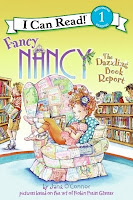Not all books are created equal. I am stealing this idea from a wonderful teacher and author Debbie Miller. In her book
Reading With Meaning, she preaches 'quality not quantity'. But how can you tell the difference?
Here's some tips on how:
1. Don’t judge a book by its cover—Have you heard
that before? Probably. When books are

published, publishing companies use cute,
but sometimes deceitful, marketing tools to get us to buy their product. For
example, books for young children are often labeled with a little number (1, 2,
or 3) in the corner that lets you know that it is appropriate. Although these
are great guides, you should also consider the story line or
subject, the length of the sentences, the difficulty of the words, and
whether or not you child is familiar with the subject or type of story. You should also know that a level 2 by one publishing company is not the same as a level 2 for another.
What to do: Look at books by the same publisher and see which ones are the most readable for your youngster. If you know that you child is reading a level 3 with that company chances are they can read other books published by the same company with the same number.
2. Don’t go
over board—I have one client whose son loves football. In an effort to get him to reading more she bought him several books on Tim Tebow the
player for the Jets. Although her intentions were good, the book choice
was not. Tim Tebow is very religious and his biography has many biblical
references in it. If you are unfamiliar with the way the Bible is set up this can be very confusing to understand, as it was for this young
boy. Sometimes the content can be right (he loves football and Tim Tebow) but the context might not be (the book was too confusing). It is
always a good idea to read through a few pages before purchasing books or explain to you child how the book 'work' so they do not have to do the figuring out themselves.
What to do: Before buying all of the books in a series or every and any book you can find on a superstar read one with you child and see if they enjoy reading them or if this is a book you want them reading.
 3.Take the path of least resistance
3.Take the path of least resistance—If your
daughter enjoys reading books about Poppleton, by Cynthia Rylant (a funny pig
and his animal friends that teach life lessons through their adventures
together) chances are she will enjoy reading other books with funny animal characters
doing funny things.
What to do: Look for books that have a similar plots, storylines, types of characters, or set-up. You don't always have to it doesn’t have to get the same series for the story line
and plot to be similar or equally as enjoyable. The librarians and booksellers are very helpful when it comes to this!
4. Do some research—Browse some of these websites
that are kid tested and parent/teacher approved! They can help point you in the right direction.
There is a reason why some books are superior to others and deserve that special space on your bookshelf. These are the books that typically we remember, they stick with us, they create some emotional reaction from us and we want to share them!
"All living things have a heart. And the heart of any living thing can be broken. "-Kate DiCamillo The Tale of Despereaux

